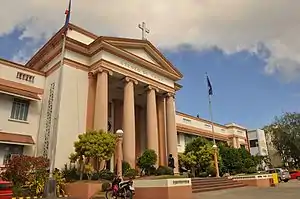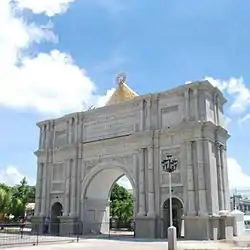Ateneo de Naga University
The Ateneo de Naga University (Filipino: Pamantasang Ateneo de Naga), also referred to by its acronym AdNU, is a private Catholic Jesuit basic and higher education institution run by the Philippine Province of the Society of Jesus in Naga City, Camarines Sur, Philippines. It was established in 1940 when the Jesuits took over the administration of the diocesan school, Camarines Sur Catholic Academy. The Jesuits renamed the school Ateneo de Naga after taking control. The Jesuits were naming all the schools that they were opening at that time Ateneo. Ateneo de Naga was the fourth school named Ateneo by the Jesuits. Typical of universities in the Philippines, AdNU has primary (since 2014) and secondary departments, which are both coeducational.
Pamantasang Ateneo de Naga | |
 The Jesuit university in the Bicol Region | |
| Latin: Universitas Athenaea Nagaensis | |
Former names |
|
|---|---|
| Motto | Primum Regnum Dei (Latin) |
Motto in English | First, the Kingdom of God |
| Type | Private Roman Catholic Research Non-profit Coeducational Basic and Higher education institution |
| Established | 1940 |
| Founder | Society of Jesus |
Religious affiliation | Roman Catholic (Jesuit) |
Academic affiliations | PAASCU FAAP AJCU-AP, CEAP, JBEC, ASEACCU, COCOPEA |
| Chairman | Atty. Avelino Sales, Jr. |
| President | Fr. Roberto Exequiel N. Rivera, SJ |
| Vice-president |
|
| Dean | List
|
| Principal | List
|
Academic staff | 377 |
Administrative staff | 306 |
| Students | 186 (Grade School) 1,500 (High School) 6,000 (Undergraduates) 7686 Total |
| Address | Ateneo Avenue , , , |
| Campus | Urban
|
| Marching Song | "The Regnum Dei" |
| Patron Saint | St. Francis Xavier |
| Colors | Blue and Gold |
| Nickname | Ateneans |
Sporting affiliations | Naga City Charter Inter-Collegiate Basketball League CEACAL BUCAL |
| Sports | basketball, volleyball, football, badminton, swimming, tennis |
| Mascot | Golden Knight |
| Website | http://www.adnu.edu.ph University http://www.adnuhs.org High School |
History
The Ateneo de Naga University was established in 1940 when American Jesuits took over the Camarines Sur Catholic Academy, a small private school under the supervision of the Diocese of Nueva Caceres, at the invitation of Bishop (later Archbishop) Pedro P. Santos of Caceres. During its first year of operation, it included intermediate grades 4-6 of elementary school. In 1941, however, the elementary school students were transferred to the nearby school run by the Daughters of Charity, and the Ateneo became an all-boys high school. The college department opened on June 5, 1947 and admitted its first female students on October 26, 1953.[1]
On September 16, 1996, the university president, Fr. Raul J. Bonoan, SJ issued a memorandum declaring the separation of the different colleges: the College of Arts and Sciences, the College of Commerce, and the College of Information Technology and Engineering. Almost a year after, the College of Education was created. In 2001, a College of Computer Studies was established. In school year 2004-2005, the University opened the College of Nursing. Most recently, The university opened a law school starting in the first semester of school year 2017-2018. The new College of Law offers a four-year program leading to a Juris Doctor (JD) degree. With these separations and additions the University now has a total number of 7 colleges.
University status was granted to the Ateneo de Naga on November 11, 1998 upon the approval by the Commission on Higher Education (CHED) on November 11, 1998 of Resolution No. 142-98.
Expansion
From 1947 to 2003, the college and high school were on the same campus, i.e. the Bagumbayan campus which became crowded when AdNU became a university. Student population grew as the university added more undergraduate programs, and the campus open space shrunk as the University built seven new buildings to provide additional facilities to the growing college student population. These seven new buildings are Christ the King University Church, Jesuit Residence, Xavier Hall, Arrupe Hall, Fernando Hall (Conference hall), O'Brien Hall (James J. O'Brien, S.J. library), the Engineering Building.
In the early 2000s, a ten-hectare land in Barangay Pacol, Naga City, was donated to AdNU. With the availability of a spacious new satellite campus, it was decided to transfer the high school from the Bagumbayan campus to the new satellite campus to decongest the former. This new property named Bonoan Campus became the new home of the high school in the summer of 2003 and also the place where the newly opened grade school was located. With the availability of more land, Ateneo de Naga can now accept a bigger student population. The same year of 2003, the high school became coeducational with the enrollment of 185 female students.
Up to the year 2013, Ateneo de Naga was the only Ateneo without a grade school. On June 4, 2014, AdNU opened its grade school at the Bonoan campus in Barangay Pacol, Naga City when it accepted students for Grades 1-3. Grades one to three classes were held at the high school building while the new grade school building was being constructed. The pre school kindergarten facility (the Ateneo Child Learning Center) was also transferred from the Bagumbayan campus to the Bonoan campus in school year 2014-15. The pre school and grade school are also coeducational.
Governance
The steady growth of Ateneo de Naga called for new structures of governance. Thus, the 1940 Articles of Incorporation were amended and new By-laws were adopted in 1979, transferring the school's high governing authority to the Board of Trustees, the majority of members were Jesuits.
School motto
The school motto in Latin, "Primum Regnum Dei", means "First the Kingdom of God" is derived from Matthew 6:33 "Seek first the Kingdom of God and all things will be given,"[2]expresses the single-mindedness with which the Ateneo de Naga University must pursue the goals of Catholic Jesuit education. The ultimate purpose of Ateneo de Naga is not knowledge for its own sake or merely professional preparation, but the reign of God and the promotion of Gospel values. In our present context, Jesuit education focuses on "the promotion of justice in the service of faith".
School seal

The Ateneo de Naga seal is similar to the seals of the other four Ateneos. It is circular and the school motto in Latin is on top of the circle with the name of the school at the bottom of the circle.
At the center of the Ateneo de Naga university seal is the escutcheon of the family of St. Ignatius of Loyola, founder of the Society of Jesus. The shield is divided vertically into ywo. The right panel shows two wolves on the sides of a hanging cauldron. The design symbolizes the hospitality and generosity of the Loyola family. On the left panel, symbolizing nobility and heroism are seven red bars on a field of gold, honoring the seven heroes of the family who distinguished themselves in the battle of Beotibar in 1321. The shield is part of the seal of many Jesuit schools in the world with which the Ateneo shares a 400-year tradition of Jesuit liberal education.
Immediately above the Loyola escutcheon is a gold crown of Mary, Mother of God, who under the title of Our Lady of Peñafrancia is the patroness of Bicol. Over Mary's crown shines the sun, symbol of Christ. On its face is the seal of the Society of Jesus in calligraphic form: the first three letters in Greek of the Holy Name of Jesus (IHS) with the cross on top and the nails of his sacred Passion underneath. The sun's rays shine over Mary's crown, the Loyola shield, and the six stars and beyond. The Sun, symbol of Christ, truth and life, shines over Mary, Ateneo, Bicol, and the world.
Arranged in a semi-circle under the Loyola shield are six gold stars representing the six provinces of Bicol Region: Catanduanes, Camarines Norte, Camarines Sur, Albay, Sorsogon, and Masbate.[3]
With its seal, the Ateneo de Naga proclaims its commitment to Christ, to the Jesuit education tradition, and to the mission of forming "men and women for others".
School name
The name Ateneo is the Spanish form of Athenæum, which the Dictionary of Classical Antiquities defines as the name of "the first educational institution in Rome" where "rhetoricians and poets held their recitations." Hadrian’s school drew its name from a Greek temple dedicated to Athena, the goddess of wisdom. The said temple, according to the Encyclopædia Britannica, was where "poets and men of learning were accustomed to meet and read their productions." Athenæum is also used in reference to schools and literary clubs. The closest English translation is academy, referring to institutions of secondary learning.
Recognition

In 2001, Ateneo de Naga was among the first 22 private higher education institutions in the Philippines granted by CHED deregulated status for five years. At the same time CHED recognized its colleges. In 2007, CHED re-designated the College of Computer Studies as a Center for Development for Excellence in Information Technology Education and designated the College of Commerce as Center of Development in Business Administration and also in Entrepreneurship. In 2007 CHED identified the Graduate School as a delivering institution for its Faculty Development Program. On June 2, 2008 CHED granted Ateneo de Naga autonomous status and approved the designation of the College of Education as a Center of Excellence in Teacher Education. The College of Computer Studies was also recognized as a CHED Center of Excellence in Information Technology in 2016.[4]
As of the year 2020, Ateneo de Naga is the only autonomous and institutionally accredited university in Bicol.
Accreditation


In 1979, the College and High School departments were the first in Camarines Sur to be accredited by the Philippine Accrediting Association of Schools, Colleges and Universities (PAASCU). They were accredited for the third time in 1992. On May 25, 2009, the PAASCU granted institutional accreditation status to Ateneo de Naga, a first for a private educational institution. [5] The Federation of Accrediting Agencies of the Philippines (FAAP) certified AdNU's institutional accreditation on June 22, 2009.
In 1991 the Depertment of Education, Culture and Sports placed the Ateneo in its list of 18 excellent universities and colleges.
Undergraduate programs
- College of Business and Accountancy
- College of Computer Studies
- College of Education
- College of Humanities and Social Sciences
- College of Law
- College of Nursing
- College of Science and Engineering
Graduate programs
- Doctoral Degree Programs
- Master's Degree Programs
- Master of Arts in Education
- Non-Thesis Programs
- College of Law: Juris Doctor (J.D.) with Thesis
Jesuits honored
The following Jesuits have a building named after them, to honor their services.
- John Joseph Phelan, S.J., science building – for his 40-plus years service.
- James J. O'Brien, S.J., library – for his long years of service.
- Francis D. Burns, S.J.. academic building – first rector, helped establish AdNU, 1940.[6]
- Fr. Raul Bonoan, S.J., Pacol campus and building on Bagumbayan campus – first president.
- Michael Rooney, S.J., high school building – guidance director, Jesuit Superior of Philippines.[7]
- Pedro Arrupe, S.J., convention hall – world-renowned Jesuit, Superior General 1965–83: coined "men and women for others" and gave social justice thrust to contemporary Jesuit education.[8]
- Richard M. Fernando, S.J., conference hall – sacrificed his life to protect Cambodian students.[9]
- Francis Xavier, S.J., student organization building – patron saint of the university.
University press

Since 2005 the Ateneo has a publishing house for university research work and for outside manuscripts. While its daily operations are managed by the university press director, all publications receive final approval of the university president, upon the recommendation of the University Press Board.[10]
Student publication
The official tertiary student publication of the university is The Pillars which was founded in 1961.[11] The senior high school student publication is Kurit Bulawan while the junior high school student publication is The Blue and Gold.
Notable alumni
- Jesse Robredo: (2010-2012) Secretary of the Interior and Local Government, (1988-2006) Mayor of the City of Naga.
- Diosdado Macapagal-Arroyo: (2010–present) congressman of Second District of Camarines Sur.
- Bea Saw, actress and Pinoy Big Brother Season 2 grand winner.
- Raul Roco, Lawyer, Philippine Senator, Education Secretaty, Congressman
Gallery
 Burns Memorial Hall
Burns Memorial Hall Bonoan Hall
Bonoan Hall Arrupe Convention Hall
Arrupe Convention Hall Christ the King University Church
Christ the King University Church Covered Court
Covered Court
References
- name ="About Us">AboutUs/ History.asp "University" Check
|archiveurl=value (help). Archived from the original on 2013-09-04. - "Ateneo de Naga University | Ranking & Review". www.4icu.org. Retrieved 2017-10-01.
- edu.ph/Aboutus/seal.asp "University seal" Check
|archiveurl=value (help). Archived from the original on 2013-11-04. - https://ched.gov.ph/wp-content/uploads/2017/09/List-of-COE-COD-as-of-May-2016.pdf
- t-16254. html "The City of Naga [الأرشيف] - أرافيل:كل شئ عن الفلبين والعرب فى الفلبين" Check
|url=value (help). www.araphil. com (in Arabic). Retrieved 2017-10-01. - "Google". www.adnu-alum.org. Archived from the original on 2015-04-24. Retrieved 2017-10-01.
- Rooney
- user1. "Pedro Arrupe, SJ (1907-1991)". Ignatian Spirituality. Retrieved 2017-10-01.
- "Richie Fernando SJ | walk the way". walktheway.wordpress.com. Retrieved 2017-10-01.
- Team, i-Governance. "Ateneo de Naga opens university press with launching of 2 Bikol books « Dagos po sa Maogmang Naga". naga.gov.ph. Retrieved 2017-10-01.
- Team, i-Governance. "Book Launchings, Art Exhibit in Ateneo « Dagos po sa Maogmang Naga". naga.gov.ph. Retrieved 2017-10-01.
| Wikimedia Commons has media related to Ateneo de Naga University. |

